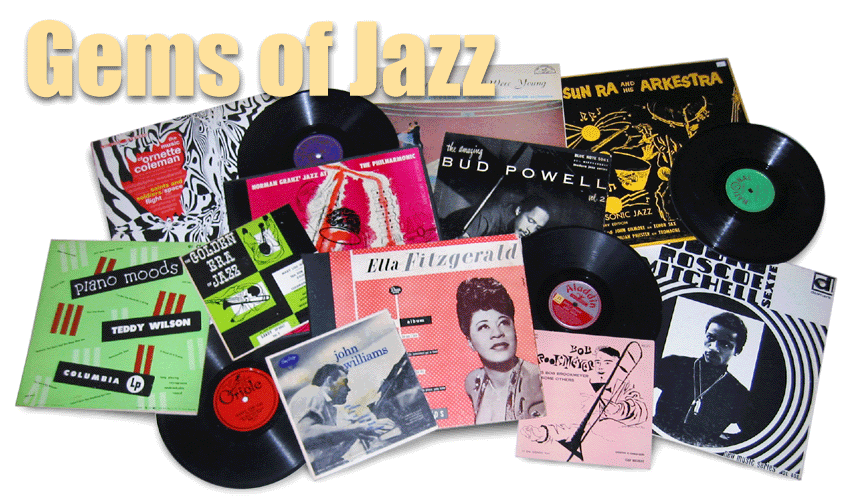Predicting the future is never easy. Predicting the future of this music we call jazz is darn near impossible. How many times have we heard "the big bands are back"? Or that X (insert "Dixieland," "soul jazz," "psychedelic," "fusion," "hip-hop," etc.) is the next big thing? Remember the Fender Rhodes? Steinways were the keyboard of the past. Anthony Braxton was the next Charlie Parker one year, unemployed and scuffling only a few years later.
So your guess is as good as mine when it comes to jazz's destiny. Who could have predicted Wynton Marsalis? Not me.
 |
| Norman makes a point. |
This milestone Granz christened "The Jazz Scene."
Released in early 1950, "The Jazz Scene" went for a stiff 25 bucks and was capped at 5,000 copies, with the stipulation that "no copies will be available after the first edition is sold." It was received with accolades by the jazz press and got a special two-page review in the industry's unofficial pub, Down
 |
| Down Beat's 1950 review of "The Jazz Scene." |
A portion of the music on the "Scene" was provided – no surprise – by members of Granz's stable of artists. Among them were Charlie Parker (recently signed), Lester Young, Bud Powell and Flip Phillips. Norman also recorded non-Mercury artists Willie Smith, Ralph Burns, Neal Hefti and George Handy. He seemed to have favored the arrangers on the album, hinting that at least some of jazz's future lay with writers rather than with improvisers.
 |
"The Jazz Scene" in its
original 78 rpm issue. |
Of the Parker contributions, "The Bird" is a piece based on "Topsy" (if I recall correctly) that runs almost five minutes – the longest performance Bird ever recorded in a studio setting. It's good, but not first rate Parker and kind of peters out at the end. According to Phil Schaap, Charlie was upstairs making "The Bird" when Neal Hefti was downstairs with the orchestra recording "Repetition" and "Rhumbacito." Parker stopped by on the way out of the studio and asked if he could sit in on the former tune. The result was Bird soloing over Hefti's arrangement during the latter half of "Repetition." A spontaneous collaboration and it works.
 |
| Gjon Mili's photo of Harry Carney at work. |
The true gem on the album is Coleman Hawkins' stellar "Picasso." According to the notes, the Hawk spent many hours formulating this free-form, solo saxophone masterpiece, and it shows. Hawkins did two or three other solo improvisations after this first effort, but "Picasso" stands out as a remarkable document by jazz's elder statesman of the tenor sax. If you've never heard it before, you're in for a treat.
The album was originally released on 78 rpm discs with a Mercury/Clef imprint. Despite Granz's pledge, the recordings were eventually issued again (and again), first on various LPs and more recently on CD. These dubs were taken from an American Recording Society release. The ARS was a record club of the variety popular back in the '50s, and it had a special deal with Granz to reissue Clef and Verve releases for its members. Each ARS record came with detailed liner notes – something the originals often lacked.
The liner notes for the ARS release of "The Jazz Scene."
The sound quality of this album is very good considering its age. We've cleaned things up here and there, and you may notice the occasional click, but mostly these files are broadcast quality. As always, they were taken from the original vinyl.
The Jazz Scene
Various Artists
Mercury/Clef
New York, NY; Various dates, 1949
1. Repetition
Neal Hefti Orchestra featuring Charlie Parker
2. I Want to Be Happy
Lester Young with Nat Cole, Buddy Rich
3. Tanga
Machito with Flip Phillips
4. Introspection
Ralph Burns Orchestra with Bill Harris, Herbie Steward
5. Sophisticated Lady
Willie Smith with Dodo Marmarosa, Red Callendar, Jo Jones
6. Frustration
Harry Carney with Billy Strayhorn, Oscar Pettiford and strings
7. The Bloos
George Handy
8. All God's Chillun Got Rhythm
Bud Powell with Ray Brown, Max Roach
9. Sono
Harry Carney with Billy Strayhorn, Oscar Pettiford and strings
10. The Bird
Charlie Parker with Hank Jones, Ray Brown, Shelly Mann
11. Rhumbacito
Neal Hefti Orchestra
12.Picasso
Coleman Hawkins






